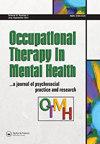患有物质使用障碍的成年人的感官偏好:它们与选择的物质一致吗?
IF 0.9
Q4 REHABILITATION
引用次数: 0
摘要
摘要本研究的目的是使用青少年/成人感官档案(A/ASP)描述患有物质使用障碍的成年人的感官偏好,并探讨感官偏好与偏好物质之间的关系。参与者(N = 57)完成了调查和a/ASP。与标准样本相比,尽管先前的研究表明该人群的感官偏好存在差异,但在A/ASP的所有四个象限中,大多数人的得分“与大多数人相似”。参与者报告说,酒精、海洛因和大麻是最受欢迎的物质。在物质组中,感觉偏好和物质偏好之间没有统计学上的显著关联,p值在.067到.904之间。职业治疗师可以使用A/ASP的结果来帮助客户发展替代性的无物质康复。本文章由计算机程序翻译,如有差异,请以英文原文为准。
Sensory Preferences of Adults with Substance Use Disorder: Do They Correspond with Substance of Choice?
Abstract The purpose of this study was to describe sensory preferences of adults with substance use disorder using Adolescent/Adult Sensory Profile (A/ASP), and to explore relationships between sensory preferences and substance of preference. Participants (N = 57) completed a survey and A/ASP. Majority scored “similar to most” in all four quadrants of A/ASP when compared to the normative samples, despite previous research indicating differences in sensory preferences for this population. Participants reported alcohol, heroin, and marijuana as most preferred substances. There were no statistically significant associations between sensory preferences and substance preferences within substance groups, with p-values ranging from .067 to .904. Occupational therapists can use results of A/ASP to help clients develop alternative substance-free recovery.
求助全文
通过发布文献求助,成功后即可免费获取论文全文。
去求助
来源期刊

Occupational Therapy in Mental Health
REHABILITATION-
CiteScore
1.20
自引率
14.30%
发文量
32
期刊介绍:
An essential journal for all OTs in mental health fields, Occupational Therapy in Mental Health provides professionals with a forum in which to discuss today"s challenges-identifying the philosophical and conceptual foundations of the practice; sharing innovative evaluation and treatment techniques; learning about and assimilating new methodologies developing in related professions; and communicating information about new practice settings and special problem areas particular to psychiatric occupational therapy.
 求助内容:
求助内容: 应助结果提醒方式:
应助结果提醒方式:


